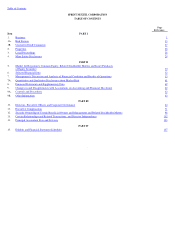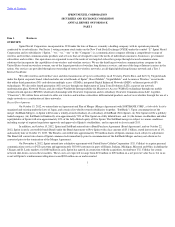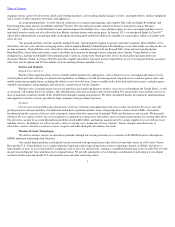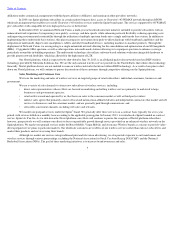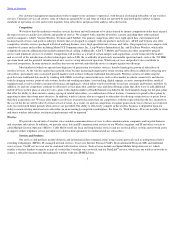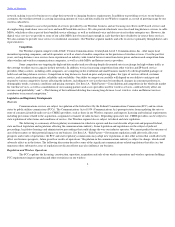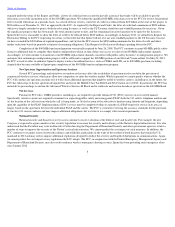Sprint - Nextel 2012 Annual Report Download - page 12
Download and view the complete annual report
Please find page 12 of the 2012 Sprint - Nextel annual report below. You can navigate through the pages in the report by either clicking on the pages listed below, or by using the keyword search tool below to find specific information within the annual report.
Table of Contents
Tower Siting
Wireless systems must comply with various federal, state and local regulations that govern the siting, lighting and construction of
transmitter towers and antennas, including requirements imposed by the FCC and the Federal Aviation Administration. FCC rules subject certain cell
site locations to extensive zoning, environmental and historic preservation requirements and mandate consultation with various parties, including
State and Tribal Historic Preservation Offices. The FCC rules govern historic preservation review of projects, which can make it more difficult and
expensive to deploy antenna facilities. The FCC has imposed a tower siting “shot clock” that requires local authorities to address tower applications
within a specific timeframe, which can assist carriers in more rapid deployment of towers. Certain local jurisdictions sought review of the rule in the
courts and a decision is expected in 2013 by the United States Supreme Court on the issue of federal agency deference in making such determinations.
The decision could potentially impact the speed of deployment of some of Sprint's telecommunications facilities, including Network Vision. The FCC
also modified its antenna structure registration process in order to help address public notice requirements when plans are made for construction of, or
modification to, antenna structures required to be registered with the FCC, potentially adding to the delays and burdens associated with tower siting,
including potential challenges from special interest groups. To the extent governmental agencies continue to impose additional requirements like this
on the tower siting process, the time and cost to construct cell towers could be negatively impacted.
State and Local Regulation
While the Communications Act generally preempts state and local governments from regulating entry of, or the rates charged by, wireless
carriers, certain state PUCs and local governments regulate customer billing, termination of service arrangements, advertising, certification of
operation, use of handsets when driving, service quality, sales practices, management of customer call records and protected information and many
other areas. Also, some state attorneys general have become more active in bringing lawsuits related to the sales practices and services of wireless
carriers. Varying practices among the states may make it more difficult for us to implement national sales and marketing programs. States also may
impose their own universal service support requirements on wireless and other communications carriers, similar to the contribution requirements that
have been established by the FCC, and some states are requiring wireless carriers to help fund additional programs, including the implementation of
E911 and the provision of intrastate relay services for consumers who are hearing impaired. We anticipate that these trends will continue to require us
to devote legal and other resources to work with the states to respond to their concerns while attempting to minimize any new regulation and
enforcement actions that could increase our costs of doing business.
Regulation and Wireline Operations
Competitive Local Service
The Telecommunications Act of 1996 (Telecom Act), which was the first comprehensive update of the Communications Act, was designed
to promote competition, and it eliminated legal and regulatory barriers for entry into local and long distance communications markets. It also required
incumbent local exchange carriers (ILECs) to allow resale of specified local services at wholesale rates, negotiate interconnection agreements, provide
nondiscriminatory access to certain unbundled network elements and allow co
-
location of interconnection equipment by competitors. The rules
implementing the Telecom Act remain subject to legal challenges. Thus, the scope of future local competition remains uncertain. These local
competition rules impact us because we provide wholesale services to cable television companies that wish to compete in the local voice telephony
market. Our communications and back
-
office services enable the cable companies to provide competitive local and long distance telephone services
primarily in a VoIP format to their end
-
use customers.
Voice over Internet Protocol
We offer VoIP
-
based services to business subscribers and transport VoIP
-
originated traffic for various cable companies. The FCC issued
an order in late 2010 reforming, among other things, its regulatory structure governing intercarrier compensation and again declined to classify VoIP
services as either telecommunications services or information services. However, it prescribed the rates applicable to the exchange of traffic between a
VoIP provider and a local exchange carrier providing service on the public switched telephone network (PSTN). The rate for toll VoIP
-
PSTN traffic is
the interstate access rate applicable to non
-
VoIP traffic regardless of whether the traffic is interstate or intrastate. The rate for non
-
toll VoIP
-
PSTN
traffic is the applicable reciprocal
9



